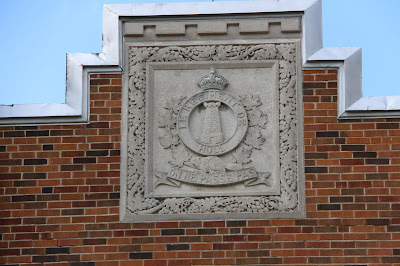The armoury, designed for the Federal Department of National Defence by Architect, Lucien Sarra-Bournet (1896-1980), was constructed as part of a major reorganization and modernization of Canadian militia. It was named after Lieutenant Colonel Charles-Michel d'Irumberry de Salaberry (1778-1829), who raised and commanded a light infantry unit called the Canadian Voltigeurs. He won distinction for repelling the American advance on Montreal during the War of 1812. Construction of the armoury started in the 1930s. On its completion on January 1, 1938 it was described as the finest drill hall facility in Canada. Parks Canada / Parcs Canada formally recognized Salaberry Armoury as a Federal Heritage Building on May 13, 1993.
Le Régiment de Hull, formed on August 7, 1914, a unit of the Reserve Armoured Corps, the only Francophone unit in the National Capital Region, is housed in Salaberry Armoury. Members of the regiment are involved in missions overseas, as part of the North Atlantic Treaty Organization (NATO) and the United Nations (UN). The unit also helps Canadians in emergency situations, such as the 1998 ice storm.
The tanks on display are M4A2 Sherman tanks. In 1946 the first of 294 M4A2 Sherman tanks arrived at Camp Borden and at the Long Pointe Ordnance Depot in Montreal. They were manufactured by the Fisher Tank Arsenal in Grand Blanc, Michigan between May 1944 and May 1945. Canadians referred to this mark of Sherman tank as the M4A2E8 or 'easy eight.' The 'E8' designation only officially applied to prototype vehicles used to test their new suspension system.
 |
| M4A2 Sherman tank, Serial Number 69215, built by Fisher, Registration Number 30129694, “Chateauguay” |
 |
| M4A2 Sherman tank, Serial Number 69224, built by Fisher, Registration Number 30129703, “Kiska” |
 |
| The motto on the badge for Le Regiment de Hull is 'On ne pas pas,' 'They shall not pass.' |
The Centurion began development in 1943. Prototypes were completed about a month after WWII's end. They were in service with Canada's forces from that time until 1970. This Centurion tank bears the name AFGHANISTAN. It is a Centurion Mark 5, serial number, CFR 52-81061. It was in service from April 1958 to September 1962 with the Royal Canadian Armoured Corps School in Camp Borden. It was taken out of service at Canadian Forces Supply Depot, Longue Pointe with total accumulated milage recorded as 5028 miles. Before arriving where it is now it was at Force Mobile Command, at St. Hubert, Quebec.
 |
| À L'OCCASION DU 30 IÈME ANNIVERSAIRE DE L'ESCADRILLE 500 HULL ROTARY |





































